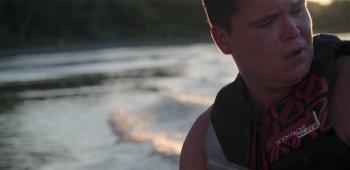Image Caption
Audio
A strong current of unknowing is what draws the families of the murdered and missing to the Red River in Winnipeg year after year, and a short documentary called this river follows the emotional ramifications of the ongoing search for clues and closure.
The film doesn’t sink into stats or names or situations, but hones in on families and their emotional experiences after loved ones go missing, said co-writer, co-director Erika MacPherson.
MacPherson and her partner in this film, Katherena Vermette, followed the work of a group of community volunteers that each year drag the Red River and search the river’s banks for possible evidence or remains of the missing. Vermette lost her own brother through unknown circumstances.
The documentary is only 20 minutes long, and is available free to watch on the National Film Board website. The film follows Kyle Kematch, who is one of the volunteers for Drag the Red.
“He’s out from May until the fall. He’s out on a boat on the Red River, with these homemade trawling devices that they have to drag the Red River,” said MacPherson.
Strands of fish hooks are attached to a piece of rebar, which Kematch drops into the river to recover what he can.
“They can pull up a lot of weight, so whatever their physical bodies can pull up, those hooks can sustain,” MacPherson explained in an interview with Dustin McGladrey of CFWE-FM.
Kematch is searching for a sister who went missing some years ago, as well as any evidence that might ease the constant unknowing of other families.
Drag the Red came together after the body of 15-year-old Tina Fontaine was pulled out of the river in 2014.
The volunteers of Drag the Red are family members of missing and murdered Indigenous women, girls, men and boys, and by working together on the initiative there’s a community that’s been built around it, which shares anger, hope, and fear, said MacPherson.
Winnipeg has five rivers running through it. The Red River has, by the nature of its own personality, become a character in the film.
“The river, clearly, is central to this situation. I mean this isn’t just a problem in Winnipeg…. This is something that we’ve since learned, researching and working on the film, that rivers are used as places to hide things all over the world.”
Vermette talks about how people have come together around the Red River. Indigenous people, historically, have used this river as a trade route, a travel route, and then the settlers came to the river.
“We shot the film on a boat. The Drag the Red boat is just a small motor boat. And there was a crew of five of us for a number of days—six days—on that boat with Kyle and his helper Calvin,” said MacPherson.
“I’ve lived in this city for almost 30 years, and I had never been on the Red River, except going across the bridge. The producer had also only been on the river a couple of times, and it’s a completely different perspective of the city, and so there’s an emotional resonance to flowing water, a body of water and…that river flows to the lake.
“Kate’s story, her brother’s body was actually found in the lake, and there’s never been an explanation of where he went in on the river. There’s just all this open-ended, this unknowing. So, even in the case of Kyle, he still has a loved one who is missing, so there’s this constant unknown of that. But for Kate, whose brother was actually found, there’s still that flowing unknowing, because they have no answers as to what happened to him. They just know that they were able to have some closure, because they were able to bring him home and put him to rest. But that’s not the case for a lot of families. And I think that’s a strong thread that ties people living in this suspended unknowing.”
Another theme that emerges in the film is the “incredible disregard that these families have experienced. That’s something that comes up in both Kate’s and Kyle’s stories in the boat and on the river, is that they share this, the emotional resonance of how little regard there is. Whether it’s just from the police or the community at large for the experience that they live with.”
An all-woman team of film-makers produced, and made this river, which won a Canadian screen award for best documentary.
It can also be seen on the What Brings Us Here Instagram site which is an ongoing sister project with the Bear Clan, a group that walks Winnipeg streets to help keep people safe.
Watch the film at https://www.nfb.ca/film/this_river/

